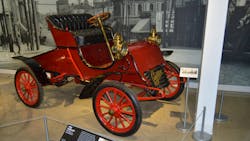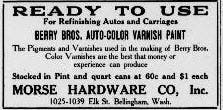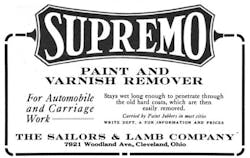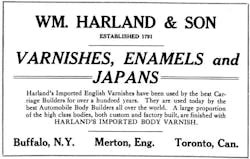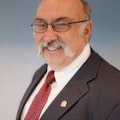Editor's Note: Welcome to YesterWreck – The Column, where each month we examine the history of the collision repair industry through excerpts from a book researched and published by industry veteran, Gary Ledoux, called YesterWreck: The History of the Collision Repair Industry in America. Check out his first installment on the pre-1900 automobile here.
The Collision Repair Industry: 1900 - 1909
It was the dawn of a new century and a new age. The horses and wheeled carriages that had provided man with transportation for hundreds of years were about to become obsolete. The speed at which man traveled on land was about to dramatically change, which also led to — you guessed it — auto accidents. The first major oil discovery was made at Spindletop, in Beaumont, Texas, in 1901. Now that America had fuel, what was needed was a practical automobile. That came in 1908 in the form of Ford’s Model T. All that was needed was an infrastructure system to provide mechanical repair and maintenance...and collision repair.
The Age of Personal Mechanics
Today, in the 21st century, finding collision or mechanical repair for one’s car is not a problem. There are plenty of car dealers, mechanical repair shops, body shops, car dealers and auto parts stores. But what if all those repair facilities and parts suppliers suddenly disappeared? Who would perform service and repairs on the new “horseless carriages?” Who would perform collision repair? Before the advent of the parts and service infrastructure in the U.S., this is what early “autoists” encountered.
Before Henry Ford created the car that everyone could afford, there were cars only the very well-to-do could afford. And if they could afford a car, they could afford a driver — a chauffeur — preferably one with a machinist’s or blacksmith’s background who could double as – the owner’s personal mechanic. This person would perform service, maintenance, and it is assumed, collision repair should the need arise.
In the May 1902 issue of Outing: An Illustrated Monthly Magazine of Recreation, author Henry Sutphen wrote, “To be a successful chauffeur, one should be able to take his machine apart, clean, inspect, and assemble it again.” This included everything from a bent fender to rebuilding the engine in the field. Repair shops were few and far between, especially in western states, and body shops, as we now know them, had not yet been invented.
It is unknown exactly when the term “body man” was first used or exactly when the body shop, as we have come to know it, first emerged. It is generally accepted that it was after 1945. What is known is, the act of auto painting, and then repairing collision damage went through a few evolutionary changes. A good starting point is a story about early chauffeurs; a unique concept for the time, not only because they drove their well-to-do employers around, but they were some of the earliest auto repair technicians.
Because of their newfound status as preeminent functionaries over the new automotive repair industry, chauffeurs became emboldened to take chances and exert liberties they might not have taken when in charge of a horse-drawn carriage. Chauffeurs became a serious problem, and a liability in some cases, for their employers. They took their employer’s cars out for joy rides at all hours of the night and drove the car recklessly exhibiting a “brazen disregard for social decorum.”
Gradually, with training and experience, their knowledge of the new technology and deftness with tools and parts fabrication placed their services in high demand. And they learned to behave themselves. Yet, they were still seen by their employers as merely servants and were treated as such, which was something that caused a great disdain among many. Extrapolating this cultural evolution into the future might explain why the auto repair industry has had, at times, a less than stellar reputation with the general public.
The Rise of the Public Parking Garage and Birth of Metropolitan Auto Repair
In the early days of motoring, most car bodies were open-top, exposed to the elements of heat, humidity, rain and snow. Thus, when they weren’t being used, they needed protection. The classic two-car garage had not yet been invented, and the livery stable, if not still accommodating horses, reeked of manure and was not a fit place for a car to be stored. In eastern cities, especially New York, finding a place to store one’s automobile, secure and out of the elements, was a real problem. As it usually does, private enterprise found a solution. Following the business model of the livery stable, a place where horses were stored in an urban area, parking garages began popping up. High urban property values and high building density left little room for private garages and thus a cottage industry of parking garages began to develop.
It didn’t take long for garage operators to offer other services to their motoring clients, such as oil for their engines, water for their radiators, and a charging station for electric cars. In the days before filling stations and the safety regulation of gasoline, garage owners sold gasoline in metal cans. This expanded into car washing, maintenance services, and even major repairs and overhauling.
Some garages even provided space, at a cost per hour, where a chauffeur could perform his own repairs to his employer’s car. It is not unreasonable then, to assume that body work, collision repair and painting could have also been performed in these new “garages.” (There was no problem with overspray getting on other cars in the garage as spray painting would not be available commercially until around 1926.)
A “well appointed” garage that performed mechanical repair and possibly body work might have a blacksmith shop, machine shop, vulcanizing area for tires, tool room and a stock room for parts.
As closed-body cars began to become more popular in the 1920’s, and certainly by the late 1930’s, and as the automotive repair and parts industry expanded, the parking garage became less relevant. Shelter for an open car was not needed, and the parking garage craze was over. Some still existed in downtown areas (as they do today) as simply a means to park a car somewhere other than the street. Those that remained in residential areas became the earliest neighborhood garages and body shops.
Timeline: 1900-1909
Here are some key points of interest for the decade:
1900
- At the dawn of the 20th century, bicycle makers, carriage makers, blacksmiths, and tinkerers of all types are becoming carmakers and car repairers. In fact, it was not unheard of for a vehicle owner to commission a plumber or pipefitter to repair a radiator or hose leak.
- There are 75 car makers operating in the US and 8,000 units in operation by 1900. Cars largely run on steam and electric, and there are even a few gasoline engines.
- From 1900 and into the early 1920’s, the wooden automobile bodies and wood-spoke wheels are painted by hand with a Badger-hair brush. The Badger hair was very fine and left virtually no brush-stroke marks. The paint pigment is very thin, which makes for poor “hiding”, plus it is brittle and cracks easily. New cars look shiny and fresh for only about a year.
1901
- The legitimacy of the automobile is questioned insofar as its use on a public street was concerned. Early travel writer Wallace Evert pens in 1906 that the automobile is not readily accepted everywhere. In fact, in many towns it is reviled. Newspapers, owned or run by anti-motorists, make a point to overemphasize the most minor of traffic accidents.
1902
- In May 1902, the state of Connecticut passes the first automotive speed law limiting automobiles to 12 mph in the city and 15 mph on country roads.
- In March 1902, nine auto clubs combine to form the American Automobile Association (AAA). (One must wonder how many collision-damaged cars have been towed to body shops by AAA tow trucks since then.)
- During this time, brothers Peter and Fred Ditzler are in the carriage-painting business but decide it would be more lucrative if they instead turn to producing their own paint and found the Ditzler Color Company. In 1903, they supply paint for all new-production Cadillacs and in 1904, they do the same for Ford.
- In August 1902, DuPont purchases their closest rival in the gunpowder business and becomes the largest explosives producer in the U.S. Paint production for DuPont is still a few years away.
- The November 1902 issue of The American Blacksmith magazine explains how difficult it is to get a satisfactory paint job on a wagon in a blacksmith shop. These are the same shops who would soon be painting automobiles.
-
June 13, 1902 – 3M is founded as the Minnesota Mining and Manufacturing Company. Originally a mining venture that did not work out, the company turned to sandpaper products in 1905.
1903
- The U.S. had 2.3 million miles of roads, although only ten percent are paved, most in the eastern part of the country. This means travel across western states is a real challenge. Highways and freeways as we know them today are still 50-plus years away. To show how capable their cars are, early automakers begin having cross-country jaunts to see who can drive from New York to the west coast the fastest.
- In a precursor to early NASCAR racing, the Oldsmobile Pirate hits a then-blistering 60 mph on the beach at Daytona, Florida. The average speed of a passenger car at the time is about 20 mph. Higher speeds eventually contribute to the frequency and severity of collisions.
- An early form of safety glass is invented by accident by Edouard Benedictus. Auto companies were not interested in the invention, however, because it was too expensive to produce and added too much cost to the car. Prior to the advent of safety glass, windshields (for those cars that had a windshield) broken in an accident produced jagged shards that could cause horrific bodily harm to drivers or passengers. Sadly, many safety-related inventions were slow in being adopted for general use by the industry, mostly for economic reasons, but sometimes because safety just wasn’t “cool.”
- Massachusetts and Missouri are the first states to issue driver’s licenses in 1903. Prior to this time, nobody figured you had to be licensed to drive a horseless carriage because, well… it was a carriage… without horses, and driving a carriage did not require a license, with or without horses. In 1954, South Dakota is the last state to require a driver’s license.
- Henry Ford launches the Model A. To aid serviceability, the body can be removed from the frame with six bolts.
1904
- It had taken about four to five years, but the inevitable happens, and car dealers begin\ taking “trade-ins” from people wanting to buy a new car.
1905
- The first purpose-built gas station opens in St Louis, Mo. Prior to the advent of the gas station, gasoline is sold in one-gallon metal cans in a variety of different stores.
1906
- In a portent of the future, Marmon uses aluminum for its chassis frame to save weight.
- Author Xenophon P. Huddy writes, “…this new means of transportation
is steering the nation to the courtroom. The motorcar, including everything connected with it, is bound to be the subject of a vast amount of litigation in the future.” Mr. Huddy could not have been more right. Today, when it comes to the collision industry, drivers sue other drivers, vehicle owners sue insurance companies, automakers, and body shops, body shops sue insurance carriers, and insurance carriers sue body shops – for all sorts of reasons. As long as humans build and drive cars, lawyers will be handily employed.
1907
- What is purported to be the first purpose-built automobile showroom opens on the corner of Broadway and 61st Street in New York City. Known then as the “Packard Garage,” it is reportedly as well appointed as a fine hotel lobby or office building.
- Aetna Insurance begins selling “auto accident” policies.
1908
- As with any new technology, those who have it first tend to be unbridled and test its limits. The automobile is a great example. By 1899, there is a public outcry for laws to help control not the conveyances so much as the people driving them, often haphazardly. It is not uncommon for horses and carriages to be driven off the road by a car, or to have pedestrians splattered with mud by a careless driver.
- In response, no doubt, to the growing recklessness of drivers, higher speeds, and the number of pedestrian accidents, inventor John O’ Leary reveals a device that attaches to a car and scoops-up pedestrians into a net upon impact. This concept may seem farfetched. However, the May 25, 2012, issue of Collision Week describes a new pedestrian airbag fitted to the front of a Volvo V40.
1909
- In its merchandise catalog, Sear and Roebuck features the Sears Motor Buggy for $395. There is no mention of an owner’s manual or a service or collision repair manual for it and no mention about how it is to be serviced.
- Ford’s Model T is built using what was then conventional means (sans assembly line) at a rate of 7 cars per hour. Five years later, with the advent of the assembly line, production rises to an astonishing 146 cars per hour.
- Despite Henry Ford’s Model T, and the general growing popularity of the automobile, some people just refuse to see or accept the future of personal transportation. In 1909, two-million horse-drawn wagons are still produced.
“When the speed craze dies out, accidents will be so rare as to stamp the automobile the very safest of road vehicles.”
Horseless Carriage magazine 1908
Excerpted from Ledoux’s book, YesterWreck: The History of the Collision Repair Industry in America available here.
About the Author
Gary Ledoux
A native of New Hampshire, Gary Ledoux retired in 2017 after a 48-year career in the automotive industry. For 18 years, he worked in various capacities in numerous car dealerships in New Hampshire. In 1988, Gary began his career with American Honda, eventually serving as the assistant national manager for American Honda’s Collision Parts Marketing Department, and was instrumental in launching Honda’s certified body shop program. He was very active in the collision repair industry, serving on various Collision Industry Conference (CIC) committees and as a three-time chairman of the OEM Collision Repair Roundtable. Today, Ledoux is a freelance writer splitting his time between his Florida home and vacation property in South Carolina. In the summer of 2018, he published his fifth book, YesterWreck: The History of the Collision Repair Industry in America.
